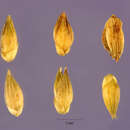Comprehensive Description
provided by North American Flora
Panicum hirsutum Sw. PI. Ind. Occ. 173. 1797
Plants robust; culms as much as 1 cm. thick and 1.5 meters or more high, simple or sparingly branching, glabrous or with a few scattered hairs, the nodes appressed-pubescent ; leafsheaths mostly overlapping, hirsute with spreading stiff hairs, these causing mechanical irritation to the skin; ligule dense, about 3 mm. long; blades flat, 20-50 cm. long, 20-35 mm. wide, scarcely narrowed to the rounded base, glabrous or with a few hairs toward the base, the margin serrulate; panicles short-exserted or included at base, 20—35 cm. long, 3-12 mm. wide, at first compact, with ascending branches, but becoming diffuse at maturity, the branches widely spreading; spikelets 2-2.2 mm. long, about 0.9 mm. wide, rather turgid, abruptly pointed; first glume scarcely half the length of the spikelet, acute, 3-5-nerved ; second glume and sterile lemma 5-7-nerved; fruit 1.5 mm. long, 0.7 mm. wide, elliptic.
Type locality: Jamaica.
Distribution : West Indies and central Mexico to northern South America.
- bibliographic citation
- George Valentine Nash. 1915. (POALES); POACEAE (pars). North American flora. vol 17(3). New York Botanical Garden, New York, NY
Physical Description
provided by USDA PLANTS text
Perennials, Terrestrial, not aquatic, Rhizomes present, Rhizome short and compact, stems close, Stems woody, Stems nodes swollen or brittle, Stems geniculate, decumbent, or lax, sometimes rooting at nodes, Stems caespitose, tufted, or clustered, Stems terete, round in cross section, or polygonal, Stems branching above base or distally at nodes, Stem nodes bearded or hairy, Stem internodes hollow, Stems with inflorescence less than 1 m tall, Stems with inflorescence 1-2 m tall, Stems with inflorescence 2- 6 m tall, Stems, culms, or scapes exceeding basal leaves, Leaves mostly cauline, Leaves conspicuously 2-ranked, distichous, Leaves sheathing at base, Leaf sheath mostly open, or loose, Leaf sheath hairy, hispid or prickly, Leaf sheath and blade differentiated, Leaf blades lanceolate, Leaf blades ovate, Leaf blades 1-2 cm wide, Leaf blades 2 or more cm wide, Leaf blades mostly flat, Leaf blades mostly glabrous, Ligule present, Ligule a fringed, ciliate, or lobed membrane, Inflorescence terminal, Inflorescence an open panicle, openly paniculate, branches spreading, Inflorescence a contracted panicle, narrowly paniculate, branches appressed or ascending, Inflorescence solitary, with 1 spike, fascicle, glomerule, head, or cluster per stem or culm, Inflorescence branches more than 10 to numerous, Lower panicle branches whorled, Flowers bisexual, Spikelets pedicellate, Spikelets dorsally compressed or terete, Spikelet less than 3 mm wide, Spikelets with 1 fertile floret, Spikele ts with 2 florets, Spikelet with 1 fertile floret and 1-2 sterile florets, Spikelets solitary at rachis nodes, Spikelets all alike and fertille, Spikelets bisexual, Spikelets disarticulating below the glumes, Rachilla or pedicel glabrous, Glumes present, empty bracts, Glumes 2 clearly present, Glumes distinctly unequal, Glumes equal to or longer than adjacent lemma, Glume equal to or longer than spikelet, Glumes 3 nerved, Glumes 4-7 nerved, Lemma similar in texture to glumes, Lemma 5-7 nerved, Lemma 8-15 nerved, Lemma glabrous, Lemma apex acute or acuminate, Lemma awnless, Lemma margins inrolled, tightly covering palea and caryopsis, Lemma straight, Palea present, well developed, Palea about equal to lemma, Stamens 3, Styles 2-fid, deeply 2-branched, Stigmas 2, Fruit - caryopsis, Caryopsis ellipsoid, longitudinally grooved, hilum long-linear.

